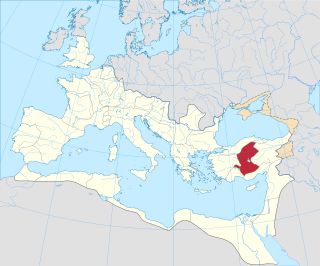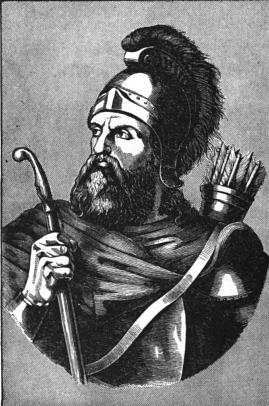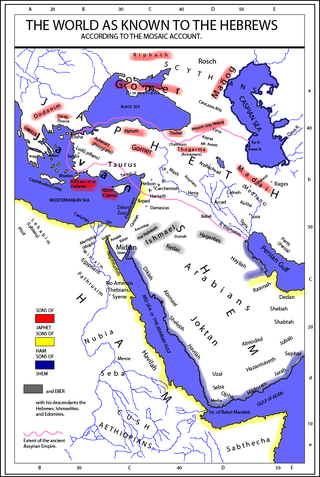
The Cimbri were an ancient tribe in Europe. Ancient authors described them variously as a Celtic, Gaulish, Germanic, or even Cimmerian people. Several ancient sources indicate that they lived in Jutland, which in some classical texts was called the Cimbrian peninsula. There is no direct evidence for the language they spoke, though some scholars argue that it was a Germanic language, while others argue that it was Celtic.

Galatia was an ancient area in the highlands of central Anatolia, roughly corresponding to the provinces of Ankara and Eskişehir, in modern Turkey. Galatia was named after the Gauls from Thrace, who settled here and became a small transient foreign tribe in the 3rd century BC, following the Gallic invasion of the Balkans in 279 BC. It has been called the "Gallia" of the East.

Japheth is one of the three sons of Noah in the Book of Genesis, in which he plays a role in the story of Noah's drunkenness and the curse of Ham, and subsequently in the Table of Nations as the ancestor of the peoples of the Aegean Sea, Anatolia, Caucasus, Greece, and elsewhere in Eurasia. In medieval and early modern European tradition he was considered to be the progenitor of the European peoples.

The Generations of Noah, also called the Table of Nations or Origines Gentium, is a genealogy of the sons of Noah, according to the Hebrew Bible, and their dispersion into many lands after the Flood, focusing on the major known societies. The term 'nations' to describe the descendants is a standard English translation of the Hebrew word "goyim", following the c. 400 CE Latin Vulgate's "nationes", and does not have the same political connotations that the word entails today.

Nimrod is a biblical figure mentioned in the Book of Genesis and Books of Chronicles. The son of Cush and therefore the great-grandson of Noah, Nimrod was described as a king in the land of Shinar. The Bible states that he was "a mighty hunter before the Lord [and] ... began to be mighty in the earth". Some later (non-biblical) traditions, interpreting the story of Jacob’s dream in the Bible, identified Nimrod as the ruler who had commissioned the construction of the Tower of Babel or of Jacob's Ladder, and that identification led to his reputation as a king who had been rebellious against God.

Galatian is an extinct Celtic language once spoken by the Galatians in Galatia, in central Anatolia, from the 3rd century BC up to at least the 4th century AD. Some sources suggest that it was still spoken in the 6th century. Galatian was contemporary with, and closely related to, Gaulish.
Cush or Kush, according to the Hebrew Bible, was the oldest son of Ham and a grandson of Noah. He was the brother of Mizraim, Phut, and Canaan. Cush was the father of Nimrod.
Tubal, in Genesis 10, was the name of a son of Japheth, son of Noah. Modern scholarship has identified him with Tabal. Traditionally, he is considered to be the father of the Caucasian Iberians according to primary sources. Later, Saint Jerome refashioned the Caucasian Iberia (Georgia) into the Iberian Peninsula and Isidore of Seville consolidated this idea.

Hayk, also known as Hayk Nahapet, is the legendary patriarch and founder of the Armenian nation. His story is told in the History of Armenia attributed to the Armenian historian Movses Khorenatsi and in the Primary History traditionally attributed to Sebeos. Fragments of the legend of Hayk are also preserved in the works of other authors, as well as in Armenian folk tradition.

Berossus or Berosus was an early-3rd-century BCE Hellenistic-era Babylonian writer, a priest of Bel Marduk and astronomer who wrote in the Koine Greek language.

In the Bible, Meshech or Mosoch is named as a son of Japheth in Genesis 10:2 and 1 Chronicles 1:5.
The Volcae were a Gallic tribal confederation constituted before the raid of combined Gauls that invaded Macedonia c. 270 BC and fought the assembled Greeks at the Battle of Thermopylae in 279 BC. Tribes known by the name Volcae were found simultaneously in southern Gaul, Moravia, the Ebro valley of the Iberian Peninsula, and Galatia in Anatolia. The Volcae appear to have been part of the late La Tène material culture, and a Celtic identity has been attributed to the Volcae, based on mentions in Greek and Latin sources as well as onomastic evidence. Driven by highly mobile groups operating outside the tribal system and comprising diverse elements, the Volcae were one of the new ethnic entities formed during the Celtic military expansion at the beginning of the 3rd century BC. Collecting in the famous excursion into the Balkans, ostensibly, from the Greek point of view, to raid Delphi, a branch of the Volcae split from the main group on the way into the Balkans and joined two other tribes, the Tolistobogii and the Trocmi, to settle in central Anatolia and establish a new identity as the Galatians.

Mannaea was an ancient kingdom located in northwestern Iran, south of Lake Urmia, around the 10th to 7th centuries BC. It neighbored Assyria and Urartu, as well as other small buffer states between the two, such as Musasir and Zikirta.

Togarmah is a figure in the "table of nations" in Genesis 10, the list of descendants of Noah that represents the peoples known to the ancient Hebrews. Togarmah is among the descendants of Japheth and is thought to represent some people located in Anatolia. Medieval sources claimed that Togarmah was the legendary ancestor of several peoples of the Caucasus.
Tiras is, according to the Book of Genesis and 1 Chronicles, the seventh and youngest son of Japheth in the Hebrew Bible. A brother of biblical Javan, its geographical locale is sometimes associated by scholars with the Tershi or Tirsa, one of the groups which made up the Sea Peoples "thyrsenes" (Tyrrhenians), a naval confederacy which terrorized Egypt and other Mediterranean nations around 1200 BCE. These Sea People are referred to as "Tursha" in an inscription of Ramesses III, and as "Teresh of the Sea" on the Merneptah Stele.

The term Japhetites refers to the descendants of Japheth, one of the three sons of Noah in the Book of Genesis. The term was used in ethnological and linguistic writings from the 18th to the 20th centuries as a Biblically derived racial classification for the European peoples, but is now considered obsolete. Medieval ethnographers believed that the world had been divided into three large-scale groupings, corresponding to the three classical continents: the Semitic peoples of Asia, the Hamitic peoples of Africa, and the Japhetic peoples of Europe.
Riphath was great-grandson of Noah, grandson of Japheth, son of Gomer, younger brother of Ashkenaz, and older brother of Togarmah according to the Table of Nations in the Hebrew Bible. The name appears in some copies of 1 Chronicles as "Diphath", due to the similarities of the characters resh and dalet in the Hebrew and Aramaic alphabets.

Ashkenaz in the Hebrew Bible is one of the descendants of Noah. Ashkenaz is the first son of Gomer, and a Japhetic patriarch in the Table of Nations. In rabbinic literature, the descendants of Ashkenaz were first associated with the Scythian cultures, then later with the Slavic territories, and, from the 11th century onwards, with Germany and northern Europe, or the Indo-European people, in a manner similar to Tzarfat or Sefarad.

Since early modern times, a number of biblical ethnonyms from the Table of Nations in Genesis 10 have been used as a basis for classifying human racial and national identities. The connection between Genesis 10 and contemporary ethnic groups began during classical antiquity, when authors such as Josephus, Hippolytus and Jerome analyzed the biblical list.